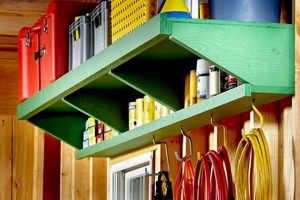The construction of a decorative display intended to hold and present glasses of champagne, typically assembled by individuals rather than purchased pre-made, is a growing trend in event dcor. These structures serve both a functional and aesthetic purpose, allowing for easy access to champagne while simultaneously creating a visually appealing backdrop. An example would be a freestanding panel with precisely cut holes designed to hold champagne flutes filled with the beverage, often adorned with floral arrangements or personalized signage.
The increasing prevalence of self-constructed champagne displays stems from a desire for personalization and cost-effectiveness in event planning. Such projects allow hosts to customize the presentation of refreshments to match the specific theme and ambiance of their event. Moreover, creating the display oneself frequently proves more economical than renting or purchasing a pre-fabricated version, while simultaneously providing a unique and memorable focal point. Historically, such customized beverage displays were less common, with event organizers typically relying on standard serving methods; however, the accessibility of online tutorials and readily available materials has spurred the rise in popularity of these personalized creations.
The following discussion will delve into the various aspects of crafting such a display. Topics covered will include material selection, design considerations, construction techniques, and safety precautions. Furthermore, different styles and variations will be examined, providing a comprehensive guide to realizing a successful and visually stunning presentation.
Essential Considerations for Champagne Display Construction
The following provides a concise set of recommendations designed to optimize the design and construction of a self-assembled champagne display, ensuring both aesthetic appeal and structural integrity.
Tip 1: Material Selection: The choice of material is critical to the stability and visual impact. Consider using sturdy wood, acrylic, or metal, ensuring that it can adequately support the weight of filled champagne flutes. For wooden structures, treatment with sealant is advisable to prevent water damage.
Tip 2: Precise Measurement: Accurate measurements are paramount for ensuring that champagne flutes fit securely within the designated openings. Measure the diameter of the flutes at their widest point and add a small tolerance (approximately 1/8 inch) to avoid overly tight or loose fits.
Tip 3: Structural Stability: Reinforce the structure to prevent collapse or tipping. This may involve using additional supports, bracing, or a wider base to distribute weight evenly. Test the stability by loading the display with the intended number of filled flutes.
Tip 4: Aesthetic Cohesion: Align the display’s aesthetic with the event’s overall theme and color palette. Consider incorporating decorative elements such as flowers, lighting, or personalized signage to enhance visual appeal.
Tip 5: Safety Considerations: Prioritize safety by ensuring that the display is placed on a level surface and is positioned away from high-traffic areas to minimize the risk of accidental collisions. Consider using non-slip materials or securing the display to a wall for added stability.
Tip 6: Transport and Storage: Design the structure for ease of transport and storage. Consider modular designs that can be disassembled and reassembled easily or utilize protective cases to prevent damage during transit.
Tip 7: Glassware Compatibility: Use glassware that is appropriate for the overall height and dimensions of the display. The choice of flute design directly affects the required hole dimensions and affects stability. Consider sourcing a specific style of glassware when designing your display.
Adherence to these guidelines will contribute to a visually appealing and functionally sound champagne display, enhancing the overall event experience and providing a sophisticated element to the event.
The concluding section will address potential challenges encountered during the building process and offer solutions for overcoming them.
1. Material Durability
Material durability directly impacts the structural integrity and longevity of a self-assembled champagne display. The choice of materials constitutes a critical decision point in the construction process, influencing both the aesthetic presentation and the ability of the display to withstand the weight and handling it will endure during an event. Inadequate material selection leads to potential structural failures, such as sagging, warping, or complete collapse, thereby jeopardizing the display and potentially causing damage or injury. Consider, for example, the difference between using thin cardboard versus reinforced plywood. The former, while inexpensive, provides insufficient support for multiple filled champagne flutes, leading to an unstable and short-lived structure. The latter offers significantly improved weight-bearing capacity and resistance to environmental factors like humidity, resulting in a more reliable and reusable display.
The practical significance of understanding the connection between material durability and self-assembled champagne displays extends beyond immediate structural concerns. It affects the long-term cost-effectiveness of the project. While initially opting for cheaper, less durable materials may seem economical, the need for frequent repairs or replacements ultimately increases the overall expenditure. Conversely, investing in higher-quality, more durable materials, such as treated wood or reinforced acrylic, reduces the long-term maintenance requirements and extends the lifespan of the display. For instance, a display constructed from marine-grade plywood, treated with a waterproof sealant, could withstand multiple uses across diverse weather conditions, rendering it a more practical and sustainable choice in the long run. Another point to consider is transportation. More durable materials withstand movement much better than flimsy materials. The need for fewer repairs adds to the long-term savings.
In summary, prioritizing material durability is paramount when constructing a self-assembled champagne display. Neglecting this aspect can lead to structural instability, potential hazards, and increased long-term costs. A comprehensive understanding of material properties and their suitability for the intended application is essential for achieving a visually appealing, structurally sound, and cost-effective outcome. Selection of appropriate materials ultimately influences the perceived quality and success of the event during which the display is used. The long-term savings that come from using more durable materials also makes this a worthwhile investment.
2. Dimensional Precision
Dimensional precision represents a crucial factor in the successful execution of a self-assembled champagne display. Accurate measurements and precise execution of those measurements directly affect the functionality, aesthetics, and overall stability of the structure. Deviations from planned dimensions can lead to instability, insecure flute placement, and an ultimately unsuccessful presentation.
- Flute Aperture Diameter
The diameter of the holes designed to hold the champagne flutes requires exacting precision. If the apertures are too small, the flutes will not fit, rendering the display unusable. Conversely, if the apertures are too large, the flutes will be unstable, increasing the risk of spillage or breakage. Accurate measurement of the flute’s diameter, typically at its widest point, followed by precise replication in the display’s construction, is imperative.
- Aperture Spacing and Alignment
The spacing between apertures must be uniform and strategically planned. Insufficient spacing compromises accessibility and increases the risk of accidental collisions between flutes. Conversely, excessive spacing can detract from the display’s visual impact. Proper alignment ensures a symmetrical and visually pleasing arrangement. The use of templates and precision measuring tools is essential to achieving accurate and consistent spacing and alignment.
- Structural Component Dimensions
The dimensions of the supporting structure, including panels, legs, and bracing, must adhere strictly to the design specifications. Inaccurate dimensions can compromise the display’s structural integrity, leading to instability or collapse. Furthermore, dimensional inconsistencies can affect the overall aesthetic, resulting in a visually unappealing or unprofessional appearance. Thorough measurement and precise cutting are critical to ensuring that all structural components fit together seamlessly and provide adequate support.
- Display Footprint and Stability
The overall footprint of the display, including its width, depth, and height, must be carefully considered to ensure stability and prevent tipping. A wide base provides greater stability but may require more floor space. A taller display, while visually impressive, is inherently more prone to tipping. The dimensions of the base and the overall center of gravity must be carefully calculated to ensure that the display remains stable even when fully loaded with champagne flutes.
In conclusion, dimensional precision is not merely a minor detail in the construction of self-assembled champagne displays, but rather a fundamental requirement for success. Adherence to precise measurements and careful execution of those measurements is essential for achieving a functional, aesthetically pleasing, and structurally sound presentation. Neglecting dimensional precision ultimately undermines the entire project, resulting in a display that is both visually unappealing and potentially hazardous.
3. Structural Integrity
Structural integrity constitutes a paramount concern in the design and construction of a self-assembled champagne display. The ability of the structure to withstand applied loads, maintain its form, and resist failure directly correlates to its usability and safety. A lack of structural integrity can lead to catastrophic collapse, resulting in property damage, personal injury, and a compromised event experience. For instance, a display constructed with inadequate support beams might buckle under the weight of numerous filled champagne flutes, causing them to fall and shatter, potentially injuring nearby individuals and creating a significant mess.
The correlation between structural integrity and the success of a self-assembled champagne display is multifaceted. First, adequate structural design ensures that the display can safely hold the intended number of champagne flutes without exhibiting signs of stress or instability. This requires careful consideration of material properties, load distribution, and joint strength. Second, structural integrity contributes to the aesthetic appeal of the display. A sagging or visibly strained structure detracts from the overall visual presentation. Third, a robust structure minimizes the risk of accidents, protecting guests and preventing costly damages. A real-world example might involve the use of reinforced joinery techniques, such as mortise and tenon joints instead of simple butt joints, to significantly enhance the load-bearing capacity of a wooden display. Similarly, utilizing thicker gauge metal or acrylic for critical support members can substantially increase its resistance to bending and buckling.
In summary, structural integrity is not merely a desirable attribute of a self-assembled champagne display, but rather a fundamental requirement for its safe and effective operation. Prioritizing robust design principles, appropriate material selection, and meticulous construction techniques is essential for ensuring the longevity, safety, and aesthetic appeal of the finished product. Neglecting structural considerations carries significant risks and undermines the entire purpose of creating a visually impressive and functional display. The application of sound engineering principles serves to transform a potentially hazardous undertaking into a reliable and impressive addition to any event.
4. Aesthetic Harmony
Aesthetic harmony, in the context of “champagne wall diy,” signifies the cohesive integration of the display with the event’s overall visual theme. It directly influences the perceived elegance and sophistication of the occasion. A lack of aesthetic harmony undermines the intended effect, creating a discordant visual element that detracts from the overall ambiance. For instance, a rustic wooden display might appear incongruous at a formal black-tie gala, while a sleek, minimalist design could seem out of place at a bohemian-themed wedding. The cause-and-effect relationship is clear: intentional design choices that complement existing decor yield a harmonious result, while mismatched elements create visual friction.
Achieving aesthetic harmony requires careful consideration of color palettes, material textures, and stylistic motifs. The color scheme of the display should align with or subtly enhance the event’s primary and secondary colors. Material selection should complement the textures and materials present in the venue. For example, a champagne display adorned with floral arrangements that mirror those used in the centerpieces creates a cohesive visual narrative. Similarly, incorporating lighting elements that match the venue’s existing lighting scheme enhances the overall ambiance. The practical application of this understanding translates into meticulous planning and attention to detail during the design and construction phase. Selecting materials, colors, and decorative elements that demonstrably complement the existing environment is key to realizing a successful outcome.
In conclusion, aesthetic harmony serves as a pivotal, though often subtle, component of “champagne wall diy.” It represents the culmination of intentional design choices aimed at creating a visually unified and elegant presentation. The challenge lies in balancing the desire for a unique and personalized display with the need to maintain a consistent visual theme. A successful champagne display not only serves its functional purpose but also elevates the overall aesthetic of the event, contributing to a memorable and visually pleasing experience for guests.
5. Safety Protocols
Safety protocols constitute an indispensable element within the realm of “champagne wall diy,” directly impacting the well-being of individuals interacting with the structure and mitigating potential risks associated with its use. The construction and deployment of self-assembled champagne displays introduce inherent hazards, including structural instability, the potential for glass breakage, and the risk of tripping or falling. Therefore, the implementation of comprehensive safety measures is not merely advisable but fundamentally necessary. A direct cause-and-effect relationship exists between adherence to stringent safety protocols and the prevention of accidents and injuries. The absence of such protocols can result in severe consequences, ranging from minor cuts and bruises to more serious injuries caused by collapsing structures or shattered glass.
The practical application of safety protocols in “champagne wall diy” involves several key considerations. Firstly, structural integrity must be rigorously assessed throughout the design and construction process. This entails selecting appropriate materials capable of bearing the intended load, employing secure joinery techniques, and conducting thorough stability tests. Secondly, measures must be implemented to minimize the risk of glass breakage. This includes utilizing high-quality glassware, providing adequate spacing between flutes to prevent collisions, and implementing clear signage warning individuals to handle the display with care. Thirdly, the placement of the display should be carefully considered to avoid obstructing pathways or creating tripping hazards. Adequate lighting and clear warnings can further mitigate the risk of accidents. Consider the example of a display constructed with flimsy materials and inadequate support. Such a structure is inherently unstable and poses a significant risk of collapse, potentially causing serious injury to bystanders. Conversely, a display built with robust materials, reinforced joints, and a stable base significantly reduces the likelihood of accidents and provides a safer environment for all.
In summary, safety protocols are not an optional addendum but an intrinsic component of successful and responsible “champagne wall diy.” Neglecting safety considerations can have severe consequences, jeopardizing the well-being of individuals and undermining the overall enjoyment of the event. A commitment to rigorous safety measures, encompassing structural integrity, glass handling, and placement considerations, is essential for ensuring that the champagne display serves its intended purpose without posing undue risks. The integration of comprehensive safety protocols transforms the “champagne wall diy” project from a potentially hazardous undertaking into a safe and enjoyable element of any celebration. These protective measures also mitigate potential legal liabilities.
6. Cost Optimization
Cost optimization, within the context of self-assembled champagne displays, refers to the strategic allocation of resources to achieve the desired aesthetic and functional outcome while minimizing expenditure. This process requires a thorough analysis of available materials, construction techniques, and design options to identify the most cost-effective solutions without compromising structural integrity or visual appeal. Effective cost optimization is paramount for individuals seeking to create a sophisticated champagne display on a limited budget.
- Material Selection Trade-offs
The selection of materials directly influences the overall cost of the champagne display. While premium materials such as high-grade acrylic or exotic hardwoods offer superior aesthetics and durability, they also command a higher price. Cost optimization necessitates a careful evaluation of alternative materials, such as reclaimed wood, medium-density fiberboard (MDF), or less expensive plastics, that can provide a similar visual effect at a reduced cost. The key lies in understanding the structural requirements of the display and selecting materials that meet those needs while remaining within budget. For example, using MDF for the main structure and reserving more expensive wood for accent pieces can significantly reduce the overall material cost.
- Design Simplification
Intricate and complex designs often require specialized tools, advanced construction techniques, and more labor, thereby increasing the overall cost. Cost optimization frequently involves simplifying the design to minimize complexity and streamline the construction process. This may entail opting for a more minimalist aesthetic, reducing the number of individual components, or utilizing readily available prefabricated elements. For instance, replacing custom-cut decorative panels with simpler, geometric shapes can significantly reduce manufacturing time and material waste. Furthermore, choosing a design that allows for easy assembly with basic tools minimizes the need for professional assistance.
- Labor Efficiency and DIY Skills
The amount of labor required to construct the champagne display represents a significant cost factor. Engaging professional carpenters or fabricators can be expensive. Cost optimization often entails leveraging do-it-yourself (DIY) skills and techniques to minimize the reliance on external labor. This requires a realistic assessment of one’s own abilities and a willingness to learn new skills. For instance, individuals with basic woodworking experience can construct a simple wooden frame, while those with metalworking skills can fabricate a more elaborate metal structure. Utilizing online tutorials and instructional videos can further enhance DIY skills and reduce the need for professional assistance.
- Waste Minimization
Material waste directly contributes to increased costs. Cost optimization necessitates implementing strategies to minimize waste during the design and construction process. This includes careful planning to accurately estimate material requirements, optimizing cutting layouts to reduce scrap, and repurposing leftover materials for other projects. For example, using computer-aided design (CAD) software to plan the cutting layout for a wooden panel can significantly reduce waste. Furthermore, saving leftover materials, such as wood scraps or acrylic offcuts, for smaller decorative elements can further minimize waste and reduce overall costs.
In conclusion, cost optimization in the context of self-assembled champagne displays represents a multifaceted approach that encompasses material selection, design simplification, labor efficiency, and waste minimization. By carefully considering these factors, individuals can create visually appealing and structurally sound displays while adhering to budgetary constraints. The key lies in striking a balance between aesthetic aspirations, functional requirements, and financial limitations.
Frequently Asked Questions
The following addresses frequently encountered inquiries pertaining to the design, construction, and implementation of self-assembled champagne displays. The information presented aims to provide clarity on key aspects of the process, ensuring a safe and successful outcome.
Question 1: What is the minimum structural load capacity required for a self-assembled champagne display?
The minimum structural load capacity varies depending on the number of champagne flutes the display is intended to hold. An accurate calculation must factor in the weight of each flute when filled to its maximum capacity, typically around 6 ounces (approximately 177 ml). The total weight must then be considered in conjunction with the material properties of the structural components to ensure adequate support and prevent structural failure. A safety margin of at least 25% is recommended to account for unforeseen loads or stresses.
Question 2: Which materials are generally considered unsuitable for constructing a champagne display and why?
Materials lacking sufficient structural integrity or resistance to moisture are generally unsuitable. Examples include thin cardboard, untreated particle board, and certain types of lightweight plastics. These materials may be unable to support the weight of the filled champagne flutes, are susceptible to warping or degradation when exposed to moisture, and pose a safety hazard due to their potential for collapse. Materials exhibiting flammability should also be avoided due to the risk of fire.
Question 3: How can one ensure the dimensional accuracy of the apertures designed to hold the champagne flutes?
Ensuring dimensional accuracy requires the use of precision measuring tools, such as calipers and rulers, to accurately determine the diameter of the champagne flutes at their widest point. A template or jig should then be created to guide the cutting or drilling of the apertures. It is advisable to create a test aperture to verify the fit before proceeding with the construction of the entire display. A tolerance of approximately 1/16 inch (1.5 mm) should be incorporated to allow for slight variations in flute dimensions.
Question 4: What safety precautions should be taken during the construction and installation of a self-assembled champagne display?
Safety precautions during construction include wearing appropriate personal protective equipment (PPE), such as safety glasses and gloves, to prevent injury from sharp edges or power tools. The work area should be well-ventilated to minimize exposure to dust or fumes. During installation, the display should be placed on a level surface and secured to prevent tipping. Avoid placing the display in high-traffic areas or near flammable materials.
Question 5: What are the recommended cleaning and maintenance procedures for a champagne display?
The appropriate cleaning and maintenance procedures depend on the materials used to construct the display. Wooden displays should be wiped down with a damp cloth and dried thoroughly to prevent warping. Acrylic or metal displays can be cleaned with a mild detergent and water. Avoid using abrasive cleaners or solvents, as these can damage the finish. Regular inspection for structural damage or loose connections is recommended.
Question 6: How can the stability of a champagne display be enhanced, particularly when used outdoors?
The stability of a champagne display can be enhanced by increasing the size of the base, adding ballast weights, or securing the display to the ground or a nearby structure. When used outdoors, the display should be positioned in a sheltered location to minimize exposure to wind. Consider using non-slip feet or pads to prevent the display from sliding on smooth surfaces. Regular monitoring of the display’s stability is essential, particularly in adverse weather conditions.
The above information is intended to provide a foundation for the successful completion of a self-assembled champagne display. Adherence to these guidelines promotes both safety and aesthetic appeal.
The following segment will explore common design variations and provide examples of successful implementations.
Conclusion
The preceding exploration of “champagne wall diy” has illuminated critical facets ranging from material selection and structural integrity to aesthetic considerations and safety protocols. Successful implementation requires a meticulous approach, prioritizing both visual appeal and functional reliability. Dimensional precision, structural robustness, and adherence to established safety guidelines are not optional enhancements but rather fundamental prerequisites for a favorable outcome. Neglecting these elements can compromise the integrity of the display and jeopardize the safety of event attendees.
As the trend towards personalized event dcor continues to evolve, a comprehensive understanding of “champagne wall diy” principles becomes increasingly valuable. Responsible execution necessitates a commitment to informed decision-making, rigorous planning, and meticulous construction practices. Whether for private celebrations or commercial events, a well-executed champagne display represents a sophisticated and memorable element, underscoring the significance of diligent preparation and unwavering attention to detail.







